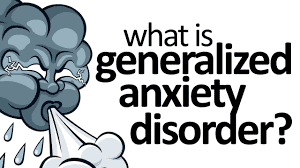“I always thought I was just a worrier. I’d feel keyed up and unable to relax. At times it would come and go, and at times it would be constant. It could go on for days. I’d worry about what I was going to fix for a dinner party, or what would be a great present for somebody. I just couldn’t let something go.”
“I’d have terrible sleeping problems. There were times I’d wake up wired in the middle of the night. I had trouble concentrating, even reading the newspaper or a novel. Sometimes I’d feel a little lightheaded. My heart would race or pound. And that would make me worry more. I was always imagining things were worse than they really were: when I got a stomachache, I’d think it was an ulcer.”
“When my problems were at their worst, I’d miss work and feel just terrible about it. Then I worried that I’d lose my job. My life was miserable until I got treatment.”
Generalized anxiety disorder (GAD) is much more than the normal anxiety people experience day to day. It’s chronic and fills one’s day with exaggerated worry and tension, even though there is little or nothing to provoke it. Having this disorder means always anticipating disaster, often worrying excessively about health, money, family, or work. Sometimes, though, the source of the worry is hard to pinpoint. Simply the thought of getting through the day provokes anxiety.
People with GAD can’t seem to shake their concerns, even though they usually realize that their anxiety is more intense than the situation warrants. Their worries are accompanied by physical symptoms, especially fatigue, headaches, muscle tension, muscle aches, difficulty swallowing, trembling, twitching, irritability, sweating, and hot flashes. People with GAD may feel lightheaded or out of breath. They also may feel nauseated or have to go to the bathroom frequently.
Individuals with GAD seem unable to relax, and they may startle more easily than other people. They tend to have difficulty concentrating, too. Often, they have trouble falling or staying asleep.
Unlike people with several other anxiety disorders, people with GAD don’t characteristically avoid certain situations as a result of their disorder. When impairment associated with GAD is mild, people with the disorder may be able to function in social settings or on the job. If severe, however, GAD can be very debilitating, making it difficult to carry out even the most ordinary daily activities.
GAD affects about 4 million adult Americans1 and about twice as many women as men.2 The disorder comes on gradually and can begin across the life cycle, though the risk is highest between childhood and middle age.2 It is diagnosed when someone spends at least 6 months worrying excessively about a number of everyday problems. There is evidence that genes play a modest role in GAD.13
GAD is commonly treated with medications. GAD rarely occurs alone, however; it is usually accompanied by another anxiety disorder, depression, or substance abuse.2,4 These other conditions must be treated along with GAD.







